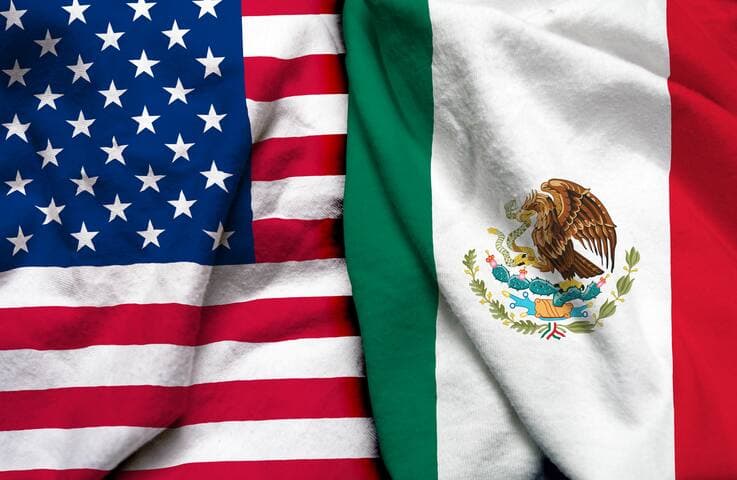How the US Election Could Affect Latin American Corporate Debt

Kathleen Monticello
Senior Vice President, Credit Analyst, Emerging Markets Fixed Income
Tariff implications. A Trump administration could lead to a universal tariff on imports, creating inflationary pressures but possibly benefiting Latin America relative to Asia and Europe.
US-Mexico trade. Mexico’s dependency on the US as a trade partner is high, and its nearshoring advantages may continue to grow. However, uncertainties around tariffs, USMCA renegotiations, and Chinese content restrictions could affect Mexican issuers.
Other LatAm markets. Latin American exporters to the US could face volume challenges if universal tariffs are implemented following a Trump win, but the region's strong trade position relative to other emerging markets offers resilience.

The US presidential election is top of mind for Latin American credit markets and issuers. The candidates’ positions on trade policy, in particular, could have divergent implications for the region’s exporters and the longevity of the recent nearshoring trend.
Here we provide insight into how we believe the region and its corporate debt issuers could fare under each election outcome.
The US and Mexico: testing a critical partnership
The relationship between the US and Mexico is arguably the most important in the region, given Mexico’s proximity and strong commercial ties to the US. The trade aspect has gained importance in recent years as US manufacturers shifted their production away from lower-cost regions, primarily in China, toward areas closer to end consumers. The pandemic accelerated the nearshoring trend, and deterioration in the relationship between the US and China has also made “friend-shoring” supply chains more appealing.
Trade data underscore these trends. The share of Mexican exports that are destined for the US had increased to 80% in 2023, illustrating Mexico’s high dependency on the US as a trade partner. In addition, Mexico became the US’ top trading partner last year, surging past China. The share of manufacturing imports from Mexico has also risen as Mexico becomes more critical to the US manufacturing supply chain.
US - Mexico Merchandise Trade 2003-2023
Current US $ in billions

Source: Source: https://www.census.gov/foreign-trade/balance/c2010.html. As of Dec 2023. For illustrative purposes only.
We see three areas of the US-Mexico trade relationship that could be influenced by the US election outcome: the impact of tariffs; the focus on Chinese content in manufacturing; and the renegotiation of the United States-Mexico-Canada Agreement (USMCA).
No surprise: tariffs would mount under Trump. Trump has said he will impose a “universal” tariff of up to 20% on all imports to the US,1 which could lead to inflationary pressures in the US and globally and prompt retaliatory trade measures. We would expect China and Europe (particularly Germany) to be hit hardest by trade barriers, which could favor capital flows to Latin America on a relative basis. That said, if the US government takes a particularly hard tone on its trade policy with Mexico, we could see capital outflows from the country as the investment and growth outlooks deteriorate.
Moreover, a universal tariff could prove difficult to implement and may ultimately be applied only to certain countries and product categories. It would also take longer – likely until 2026 – to push through such a plan. Trump has additionally called for a 60% tariff on Chinese goods1, and after having raised tariffs on China to around 25% during his first administration, an increase to 60% seems feasible (and it could happen faster than the universal tariff). Higher tariffs on China could accelerate the nearshoring trend in Mexico, as manufacturers in China face lofty costs to export to the US.
The Biden-Harris administration, meanwhile, has maintained some of the tariffs implemented under Trump and added others to some product categories, such as solar panels, electric vehicles (EVs), and batteries. We would expect Harris to maintain these tariffs and broadly continue current trade policy. If Harris wins the election, we would expect policy continuity in most cases, including ongoing tariffs on Chinese products, which would favor Latin America relative to Asian emerging markets, for example. New proposed tariffs on electric vehicle batteries, semiconductors, steel, and medical products could hurt some manufacturers in Mexico, but would also cause challenges for manufacturers from other emerging markets.
Chinese content in Mexican imports would be under the radar in either outcome. Given the broader movement of US manufacturing from China to Mexico, China has increased investment in Mexico in search of an entrance to the US market. China accounted for nearly 40% of Mexico’s “nearshoring demand” in 2023.2 Chinese companies established in Mexico are now meeting internal market demand but are also supplying Mexican manufacturers as they seek to remain part of the valuable US supply chain.
Mexico Tier-1 Nearshoring Absorption by Country of Origin, 2023

Source: FIBRA Prologis research, July 2024. For illustrative purposes only.
Given the restrictions in the USMCA on content from the member countries, Mexico is working to improve documentation and management of Chinese content. Politicians from both US parties have advocated high tariffs or total bans on Chinese EVs imported to the US from Mexico, and we would expect both candidates to stay committed to limitations on Chinese content in imports.
Renegotiations of the USMCA will have different areas of focus. The US, Mexico, and Canada will review the USMCA trade agreement in 2026. We would expect a Trump administration to try to renegotiate several points related to EVs and to incorporate some elements of immigration policy. A Harris administration is likely to incorporate more protections related to climate change.
Immigration and border security are also critical issues that could be used as bargaining chips in negotiating the US-Mexico trade relationship. In 2019, Trump threatened a 5% tariff on all Mexican imports if Mexico’s government did not take action on immigration. Ultimately, bilateral negotiations avoided this tariff, but this precedent raises the possibility of a similar threat under Trump.
US relations with the rest of Latin America: Venezuela could be a sticking point
The US is an important trade partner outside Mexico as well, and while immigration is an issue in other parts of Latin America, we would not expect specific policies to affect other countries in the region with the exception of Venezuela. The former Trump administration escalated sanctions against Venezuela, while the Biden administration rolled back some of these sanctions in exchange for a guarantee of free elections. This could become a point of contention depending on how the new US administration works with its allies in the region.
How will Latin America’s credit markets fare?
We see a number of ways that LatAm credit markets and issuers could be affected by the US election outcome.
The macro (top-down) impact
The universal tariff Trump has proposed would likely have an inflationary and growth-dampening effect on the US and global economies and act as a drag on global trade – effects likely to more than offset the benefits of potential tax cuts. The tariffs would hit especially hard in Asia and Europe, given that these regions lack an agreement like the USMCA and have relatively higher logistics costs. This could position Latin America more favorably.
US interest rates are expected to decline, perhaps faster if the US tips into a recession. The candidates would likely handle this scenario differently, with implications for the strength of the dollar. Trump’s trade and tariff policies, for example, could lead to temporary strengthening of the US dollar in an inflationary environment. Under Harris, on the other hand, we would expect a gradual continuation of the dollar’s depreciation in a “status quo” situation.
Under Harris, we would expect to see a similar growth path as that under Biden, with a gradual cooling of the US economy in the near term.
We believe that in the US and globally, companies are preparing for a potential Trump administration, increasing inventories of imported products in case they are hit by tariffs that engender higher costs.
The micro (bottom-up) impact
We’ve spoken with issuers across the region to understand how they are interpreting and preparing for potential risks from the US election outcome.
First, we believe noise surrounding the potential for new tariffs, scrutiny of Chinese content, and the USMCA review has made investors somewhat cautious on investments in Mexico and may be causing a temporary pause in the nearshoring theme. For instance, Tesla announced that it will postpone construction of a plant in Mexico given uncertainty about Mexico’s position as a trade partner post-election. The postponement of these investments may have an impact on Mexican REITs (known as FIBRAs) given the recent high demand for industrial real estate used for manufacturing and logistics. The FIBRAs could lose some of their pricing power if uncertainty persists or if policies are implemented that reduce Mexico’s attractiveness as part of the manufacturing supply chain. In the long term, we believe the nearshoring trend will continue and that demand for industrial assets in Mexico will remain strong – the policy uncertainty would likely only slow what has been a robust trend.
We also spoke with issuers in Latin America about the direct impact of some of Trump’s proposed policies. Some operate in the US and import products that could face higher costs if Trump’s universal tariffs are implemented.
On the other hand, a large share of Latin American issuers export to the US. Universal tariffs would hit auto parts manufacturers based primarily in Mexico, which have said they would likely pass through most of the tariff costs to prices. They expect higher prices would ultimately dent the volume of cars sold in the US along with demand for their products. However, they believe this would be a one-time effect.
Consumer companies that export to the US also say they would likely pass potential tariffs through to prices, primarily in the categories that are less price-elastic. These issuers also expect a one-time negative impact on volumes.
In the oil and gas sector, currently one Mexican company we spoke with exports crude oil to the US to be refined and then imports it back to Mexico for final use. The universal tariff would add costs to this process and require price increases.
For commodity and petrochemical producers, typically their products are priced based on international reference prices. The tariffs would make products produced outside the US more expensive, with costs likely fully passed through to prices. Positively, many commodity producers in Latin America are among the lowest-cost producers in the world (in pulp and paper, for example), so Latin American commodities would remain competitive with US producers in some cases.
In the medium term we could see some imports replaced with US-made products, but as noted, we believe that given the proximity, low labor costs, and natural resources available in Latin America, exports to the US will continue to be attractive for US supply chains and final consumers.
Democratic candidate Kamala Harris has pledged to fight price gouging in order to rein in voters’ grocery costs. This could have a negative effect on Latin American consumer companies that operate in the US and export to the US, considering they may not have full flexibility on their pricing strategy. However, most companies we consulted said they were skeptical about how this policy could be implemented.
Positioning in Latin America corporate debt
Overall, we believe the main risks of the US elections for Latin America relate to trade policy. Mexico is most at risk, given the importance of trade with the US, its position as a bridge for Chinese content into the US, and the expectation of USMCA renegotiations in 2026. In a Trump scenario with implementation of universal tariffs, we believe Latin America is well positioned relative to Asia and Europe given its proximity and lower costs. Under both the Trump and Harris scenarios, we believe the USMCA will be extended but renegotiated, likely including some concessions from Mexico.
We are cautious on Mexican corporate debt in the medium term, given that uncertainty may slow some investment decisions, but we believe Mexico and Mexican issuers will benefit from their strong relationship with the US in the long term. In other parts of Latin America, we believe issuers that export to the US may see a hit to volumes if a universal tariff is implemented, but we do not expect a big impact on the credit fundamentals of these companies.
Will Latin America remain the ‘sweet spot’?
Latin America has inhabited the “sweet spot” in emerging markets for several years amid the trade war with China and the war in Ukraine. Mexico has experienced some volatility during the past few months given election results there, which allowed AMLO to have a de facto majority in Congress in the month of September before Claudia Sheinbaum taking office in October. He was able to approve a controversial judicial reform, and further potential constitutional reforms could threaten business confidence. Following this period, we expect relative political stability in Mexico as well as Brazil and Chile.
The positive impact of declining interest rates on growth in the region should become more evident in the near term. Latin America should remain somewhat isolated from many geopolitical hot spots, making it relatively more attractive. In this sense, we believe it can continue to be a favored region in emerging market credit. With our extensive experience and resources, we believe we are well-positioned to identify and capitalize on compelling investment opportunities in the region while navigating complexities of the local markets.
1 Source: PBS News https://www.pbs.org/newshour/economy/trump-favors-huge-new-tariffs-how-do-they-work
2 Source: Source: FIBRA Prologis research, July 2024. For illustrative purposes only.
Disclosure
Investing involves risk, including possible loss of principal. The information presented herein is for illustrative purposes only and should not be considered reflective of any particular security, strategy, or investment product. It represents a general assessment of the markets at a specific time and is not a guarantee of future performance results or market movement. This material does not constitute investment, financial, legal, tax, or other advice; investment research or a product of any research department; an offer to sell, or the solicitation of an offer to purchase any security or interest in a fund; or a recommendation for any investment product or strategy. PineBridge Investments is not soliciting or recommending any action based on information in this document. Any opinions, projections, or forward-looking statements expressed herein are solely those of the author, may differ from the views or opinions expressed by other areas of PineBridge Investments, and are only for general informational purposes as of the date indicated. Views may be based on third-party data that has not been independently verified. PineBridge Investments does not approve of or endorse any republication of this material. You are solely responsible for deciding whether any investment product or strategy is appropriate for you based upon your investment goals, financial situation and tolerance for risk.




